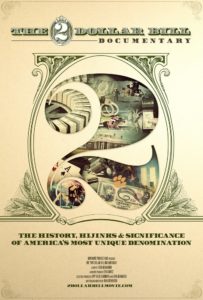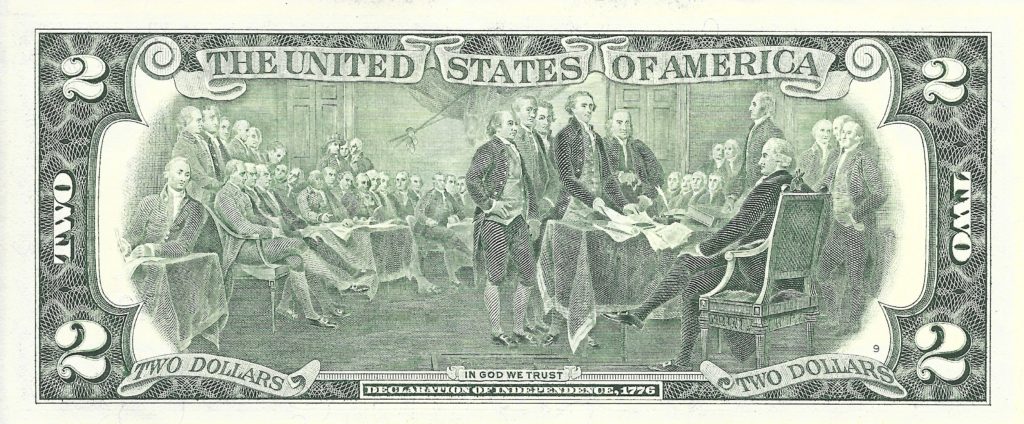Film Looks at Quirky Talisman of U.S. Currency
Posted on April 26th, 2017 in Entertainment, Movies, Public Discourse with 0 Comments
You probably have one in stashed in a drawer. Or wadded up in a corner of your wallet. And you’re not sure why.
Live, from 1976, it’s the $2 bill!
Yours may still be crisp, with its bust of Thomas Jefferson on the front and, on the back, it’s detailed etching of the Declaration of Independence’s presentation to the Continental Congress. And, according to The Two Dollar Bill Documentary (2015), what you think you know about it might be wrong.
 “It’s not a stretch to say that most Americans are decidedly misinformed about the $2 bill,” says John Bennardo, who produced and directed the film.
“It’s not a stretch to say that most Americans are decidedly misinformed about the $2 bill,” says John Bennardo, who produced and directed the film.
Indeed, one of the Frequently Asked Questions on the Treasury Department website is: “Why did the Treasury Department remove the $2 bill from circulation?”
Well, it didn’t. There are about 1.2 billion in circulation.
Like many niche pieces of Americana, the $2 bill has its fans.
“People have decided it’s a kind of talisman [and treat it] in a way that they don’t treat other money,” says David Wolman, author of “The End of Money.”
The Two Dollar Bill Documentary looks at why.
Following a brief history of $2 notes in the United States, along with a look at design elements unique to the bill, Bennardo interviews MIT graduate Erik Mintz, who conducted a survey of why people think a $2 bill is somehow special and worth holding onto. The top three responses were:
- The misperception of rarity (46 percent);
- A sense of nostalgia (29 percent); and
- Belief they are lucky (11 percent).
In fact, the two is rare only in comparison to other denominations of U.S. currency. And the note rarely is worth more than $2. (As with any bit of currency, a flaw or unique serial number could boost its value to collectors.)
But the two has some design elements that set it apart. The front bears the image of Jefferson, a man widely regarded as quirky – like the $2 bill. The second president first appeared on the 1869 U.S. note. The same image has appeared on subsequent Federal Reserve notes. (I’ll leave it to the film to explain the difference between U.S. notes and Federal Reserve notes.)
The first “modern” version, issued in 1928, had a front similar to the current bill but with the serial number and Treasury seal in red. The back featured an etching of Jefferson’s Virginia home, Monticello, a structure as quirky as he was. After minor, cosmetic changes in 1953 and 1963, the notes were discontinued in 1966.
By 1976, the federal government wanted to save money by printing fewer bills while keeping the same value of money in circulation. The answer: Replace some singles with twos. The political cover? Celebrate the Bicentennial! Those disparate motivations gave birth to the current $2 note, which has a similar front but with the serial number and seal in green.
It is the rear of the 1976 note that really draws the eye. It features an altered image of the John Trumbull painting “Declaration of Independence.” (Due to space limitations, five of the men in the painting were deleted.) The image is engraved in an older, more-complex process known as intaglio. The result is a bill that many consider too beautiful to spend.
“There is a lot more intaglio printing on the two than on the other denominations,” says Charlene Williams, manufacturing director at Bureau of Printing and Engraving facility in Fort Worth, Texas. “It kind of goes back to the old style of currency. People love the intaglio print.”
The sense of nostalgia prompted by the $2 bill often, but not always, stems from where or how a person received one. Many are passed from one generation to the next, so they evoke memories of beloved parents or grandparents. But the film also includes heartwarming stories of twos from World War II and 9/11.
The perception of luck associated with the two swings both good and bad. Racetracks took $2 bets and often paid off winners in twos. Of course, those winners didn’t always want to tip off others that they’d been hanging out at the track. Some folks claim to see an image of the devil on the bill; others identify clues they believe link twos to the Illuminati. (Paging Dan Brown.)
There is a perception that merchants don’t like to accept $2 bills – that there is no place for them in a cash drawer and that vending machines won’t take them. But the issue appears to be more with a merchant’s knowledge and attitude. Those that don’t mind twos manage to find a place for them, and modern vending machines that accept paper money have the capacity to accept twos – they simply must be programmed to do so.
The film offers jaw-dropping stories of merchants who simply don’t believe $2 bills are real. At one Best Buy, store employees accused a customer who tried to use them of counterfeiting and called police; an officer actually took the man to jail before someone called the Secret Service and got the facts.
Which brings us to the uniqueness of a $2 bill transaction: the opportunity it offers to start a conversation.
The two appears to have a mnemonic effect on people.
Bennardo illustrates this by interviewing a man named Matt Zaklad, along with the proprietor of a food truck he patronizes. Zaklad makes a habit of spending twos, and both men recall how quickly the food-truck workers began recognizing Zaklad and remembering his usual order.
Groups as diverse as marijuana activists, 2nd Amendment enthusiasts and Clemson University football fans have used $2 bills as political props to demonstrate their economic impact.
In the end, The Two Dollar Bill Documentary appears to tell us that the note is worth, to each of us, whatever we impute to it. For most folks, as well as banks and merchants, that value is $2. But for some individuals, the two represents a loved one, a memory or a cause. It’s hard to put prices on those.
###
Stu Robinson does writing, editing, media relations and social media through his business, Phoenix-based Lightbulb Communications.
Tags: $2 bill, Bicentennial, Erik Mintz, intaglio, Matt Zaklad, Monticello, Thomas Jefferson






COMMENTS
There are no comments yet.